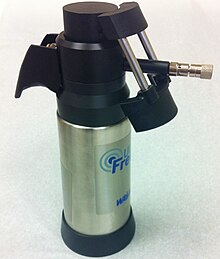Cryosurgery (cryotherapy) is the use of extreme cold in surgery to destroy abnormal or diseased tissue. The term comes from the Greek words cryo (κρύο) ("icy cold") and surgery (cheirourgiki
– χειρουργική) meaning "hand work" or "handiwork". Cryosurgery has been
historically used to treat a number of diseases and disorders,
especially a variety of benign and malignant skin conditions.
Warts, moles, skin tags, solar keratoses, Morton's neuroma and small skin cancers are candidates for cryosurgical treatment. Several internal disorders are also treated with cryosurgery, including liver cancer, prostate cancer, lung cancer, oral cancers, cervical disorders and, more commonly in the past, hemorrhoids. Soft tissue conditions such as plantar fasciitis (Jogger's heel) and fibroma(benign
excrescence of connective tissue) can be treated with cryosurgery.
Generally, all tumors that can be reached by the cryoprobes used during
an operation are treatable. Although found to be effective, this method
of treatment is only appropriate for use against localized disease, and
solid tumors larger than 1 cm. Tiny, diffuse metastases that often coincide with cancers are usually not affected by cryotherapy.
Cryosurgery works by taking advantage of the destructive force of freezing temperatures on cells. When their temperature sinks beyond a certain level ice crystals begin forming inside the cells and, because of their lower density, eventually tear apart those cells. Further harm to malignant growth will result once the blood vessels supplying the affected tissue begin to freeze.
Liquid nitrogen
Cryogun used to spray liquid nitrogen
A common method of freezing lesions is using liquid nitrogen
as the cooling solution. This −196 °C (−321 °F) cold liquid may be
sprayed on the diseased tissue, circulated through a tube called a
cryoprobe, or simply dabbed on with a cotton or foam swab.
Carbon dioxide
Carbon dioxide is also available as a spray and is used to treat a variety of benign spots. Less frequently, doctors use carbon dioxide "snow" formed into a cylinder or mixed with acetone to form a slush that is applied directly to the treated tissue.
Argon
Recent advances in technology have allowed for the use of argon gas to drive ice formation using a principle known as the Joule-Thomson effect. This gives physicians excellent control of the ice, and minimizing complications using ultra-thin 17 gauge cryoneedles.
Dimethyl ether – propane
A mixture of dimethyl ether and propane is used in some preparations such as Dr. Scholl's Freeze Away. The mixture is stored in an aerosol spray
type container at room temperature and drops to −41 °C (−42 °F) when
dispensed. The mixture is often dispensed into a straw with a
cotton-tipped swab.
